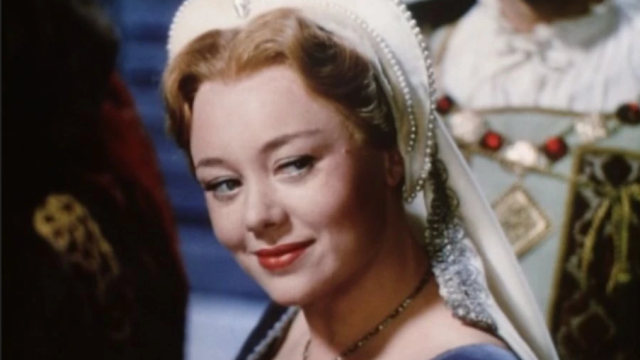Oh, the history on this is dreadful. For one, it does persist in that strange pretense that English colonies in the New World existed well before they actually did; true, John Cabot had gone to Newfoundland by the time Our Heroine was more than about a year old, but it would take until the reign of her niece before the English would seriously contemplate colonization there again. For another, her brother was only five years older than she and hardly the middle-aged portly man he’s so often shown to be. Still, it’s at least more accurate than The Tudors, wherein she’s called by her sister’s name and murders a fictional king of Portugal?
Our Heroine is Mary Tudor (Glynis Johns, still alive at 99), youngest surviving child of Henry VII (dead by the time of this movie) and Elizabeth of York (ditto). Her older brother, Henry VIII (James Robertson Justice), is in the process of arranging a marriage for her to Louis XII of France (Jean Mercure). She’s less than thrilled at the prospect; Louis is 52 and gout-ridden. She is also being wooed by the Duke of Buckingham (Michael Gough) and commoner Charles Brandon (Richard Todd). Mary is very much supportive of the suit of Charles, though she’s willing to use the duke to get what she wants.
The stretch of Disney films before Old Yeller or so is the most obscure, I suspect. Treasure Island gets discussed some, and of course 20,000 Leagues Under the Sea, but the notion that there’s nearly twenty live-action films from the 1950s, mostly costume dramas of one sort or another, that got released by the studio is a shocking one. Oh, that includes a couple of Davy Crocketts and some Zorro, but most of these films are utterly forgotten by the general public. Even many Disney buffs are unaware that they exist. I’m not sure I’ve ever seen this one myself; if I have, it’s been decades. Certainly it isn’t on Disney+—it’s so forgotten by even the studio that it’s available in its entirety on YouTube.
Mary Tudor wasn’t quite this headstrong and independent, but she was shockingly so for a woman of her time. She didn’t want to marry Louis and said so, to the accurate annoyance and dismay of her brother. She did indeed extract a promise from Henry that, at Louis’s death, she’d be permitted to marry whom she wished. He almost certainly didn’t mean it, but she got her way in the end. Two kings tried to arrange a second marriage for her, and she got her own way for all that.
One rather wonders where Mary would’ve gotten the idea that she should be allowed to marry for love. Oh, I suppose technically Henry did, in a complicated and roundabout sort of way, but it was also very definitely a state marriage that was intended to bolster the alliance between England and Spain. True, Charles Brandon had actually been raised to Duke of Suffolk in 1514 and was therefore not a commoner. But an alliance with France was considerably more important than an alliance with Henry’s own boyhood friend. Even a second marriage to the person of her choice instead of a second political marriage was more than the average princess would have expected, surely.
There was a Duke of Buckingham at this time; he was eighteen years older than Mary. He would be executed for treason seven years after the events of the movie. As it happens, one of the ladies-in-waiting who attended Mary in France during her time as queen was the younger daughter of a knight who, 487 years ago at this writing, would be in the Tower of London, where she had been brought as queen a few years earlier and where she would die a traitor a couple of weeks later. This was a complicated time in English history, and of course Mary Tudor was right in the thick of it.
This was a lush, opulent movie. Director Ken Annakin said he had to sublimate his own desires to Walt’s, but he also felt that Walt was better at understanding the will of the people than he was. The budget, money Walt was unable to bring across the Atlantic in cash, is visible onscreen; there are incredible costumes and exquisite matte paintings. The cast is full of surprising touches—oh, more surprising seventy years on in some ways, but still. And if some details are inaccurate, others are closer than you’d expect. There are certainly worse fates for Mary Tudor than being portrayed by Glynis Johns, come to that, and she suffered through some of it.
I don’t expect the dowry of an English princess, just a bit of support in my Patreon or Ko-fi!

